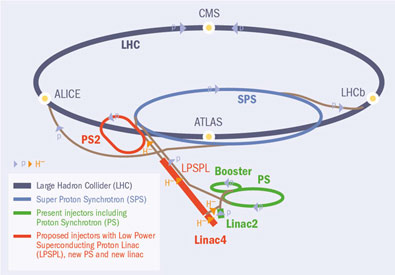The Super-LHC is on the starting blocks
Continue reading page | 1 | 2
This article appeared in the CERN Courier on 8 July 2008
While the eyes of the world are looking forward to witnessing the first beams and collisions in the LHC this year, preparation for its luminosity upgrade, the Super-LHC, is already under way.
Exploiting the full potential of physics at the LHC, which includes R&D that is focused on upgrading luminosity, is the highest priority of the European Strategy for Particle Physics, which was adopted unanimously by the CERN Council in July 2006 (CERN Courier September 2006 p29). The first LHC physics approaches ever nearer as the LHC hardware commissioning makes steady progress towards providing beams to the experiments later this year (Protons knock on the LHC’s door). Meanwhile, accelerator and detector experts are already looking farther into the future. They have begun preparatory work for the luminosity upgrade, known as the Super-LHC (SLHC), which was announced in April with an event at CERN to "kick-off" R&D.
Read 'April event kicks off for the SLHC'
The current LHC configuration is set up to produce proton–proton collisions at a centre-of-mass energy of 14 TeV and a luminosity of up to 1034 cm–2s–1. It will also provide high-energy lead–lead ion collisions at a centre-of-mass energy as high as 1.15 PeV (1150 TeV). The SLHC project, however, aims for a tenfold increase in luminosity for 14 TeV proton–proton collisions, achieved through the successive implementation of several new elements and technical improvements that are scheduled for 2012–2017. These include the major replacement of several accelerators in the LHC proton-injector chain, upgrades of the LHC-interaction regions and enhancements to the general-purpose experiments ATLAS and CMS.
Understanding how to improve the luminosity yield of the LHC has required careful scrutiny of the whole proton-injection and accelerator chain to seek out bottlenecks, inherent weaknesses and reliability problems. The findings are that more luminosity gain can be obtained from improvements to the injector chain than from changes in the LHC machine itself. This is no surprise, considering that some elements of the injector chain date from as early as 1959, when no one would even have dreamed of a superconducting accelerator the size of the LHC. In the current chain, protons pass successively from the source through Linac2, the Booster, the PS and the SPS before final injection into the LHC. The SLHC plans propose a future sequence of Linac4, the Low-Power Superconducting Proton Linac (LPSPL), PS2 (a new machine) and the SPS. Figure 1 shows both present and future schemes, while the aerial view shows more directly how the injectors will be positioned on the site at CERN.
The first bottleneck in the present layout occurs with the injection of proton bunches from Linac2 into the Booster. Protons are injected at 50 MeV by a multiturn injection process that inherently dilutes the beam brightness (the current within a given emittance). Much can be gained from using H– particles in the linac followed by injection in the Booster using a charge-exchange technique that removes excess electrons. This method avoids a dilution of beam brightness and directly translates into a luminosity increase in the LHC. Capturing and accelerating the now more brilliant beam requires an energy increase in the linac, thus reducing the beam self-repulsion in the Booster. This justifies the present 50 MeV proton linac (Linac2) being replaced by a new 160 MeV linac (Linac4) operated with H– ions. Plans for Linac4 are well advanced and its construction will begin soon, aiming for commissioning by 2012. This will result in a doubling of peak LHC luminosity.
Continue reading page | 1 | 2






